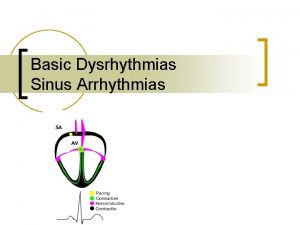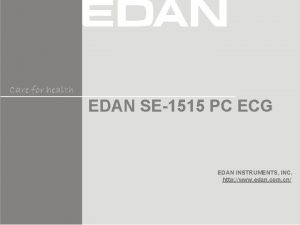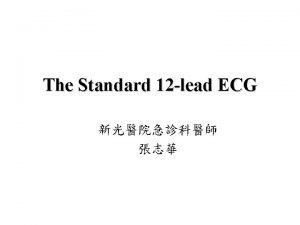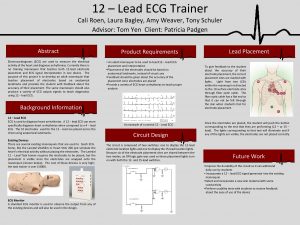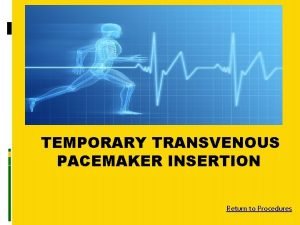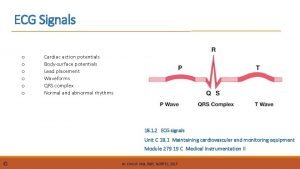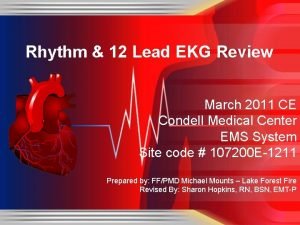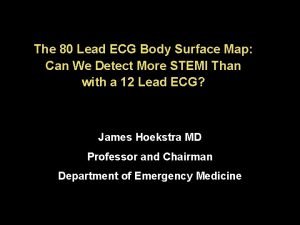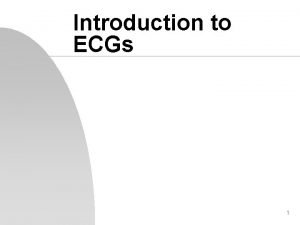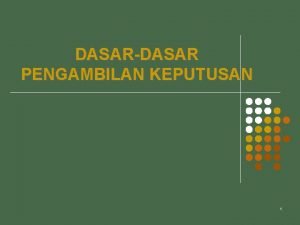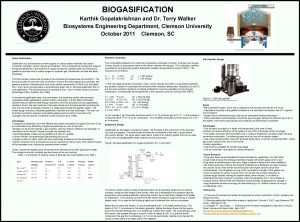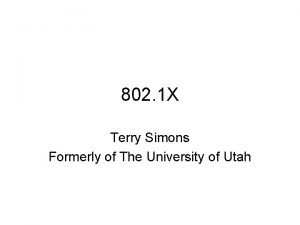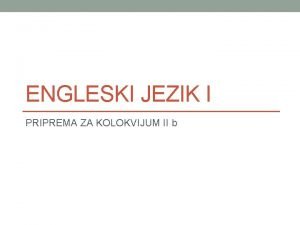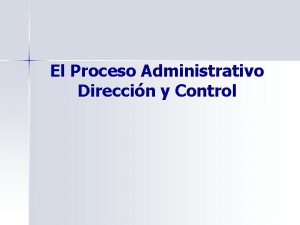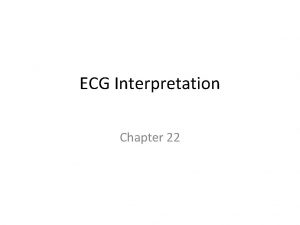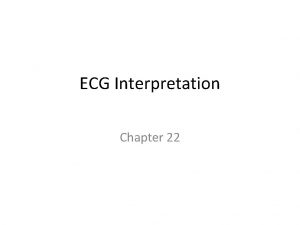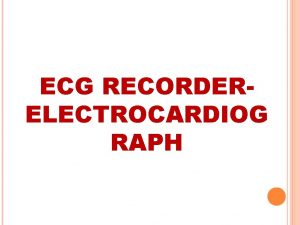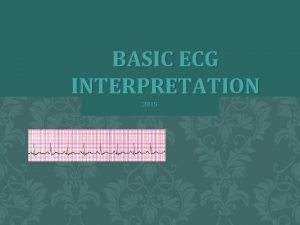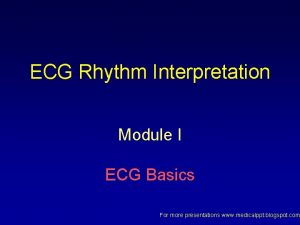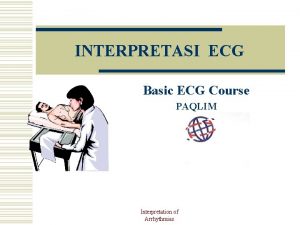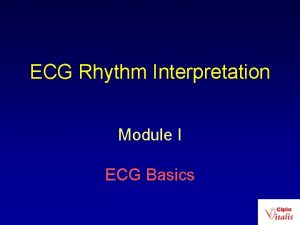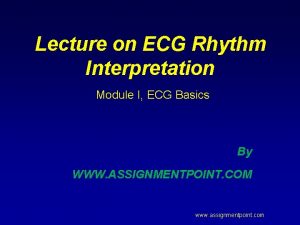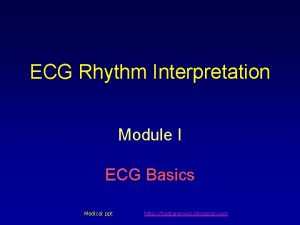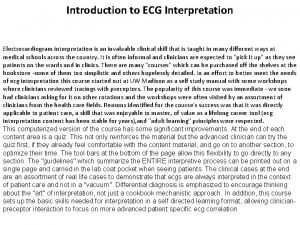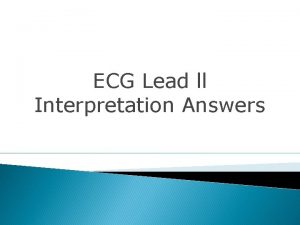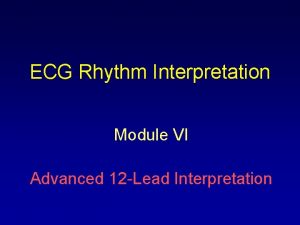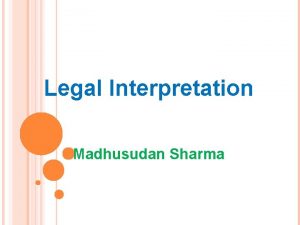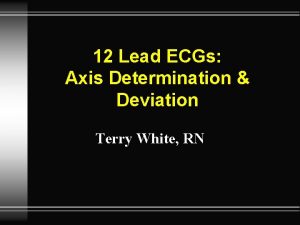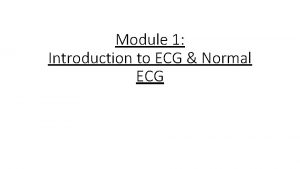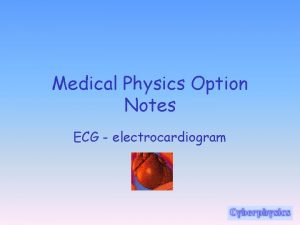Essentials of 12 Lead ECG Interpretation Terry White





































- Slides: 37

Essentials of 12 Lead ECG Interpretation Terry White, RN, EMT-P

Topics Anatomy Revisited l The 12 Lead ECG Device l The 12 Lead ECG Format l Waveform Components l Lead Views l

Anatomy Revisited l RCA – – – l right ventricle inferior wall of LV posterior wall of LV (75%) SA Node (60%) AV Node (>80%) LCA – – septal wall of LV anterior wall of LV lateral wall of LV posterior wall of LV (10%)

Anatomy Revisited l l l SA node Intra-atrial pathways AV node Bundle of His Left and Right bundle branches – left anterior fascicle – left posterior fascicle l Purkinje fibers

The 12 Lead ECG Device l Device serves as a voltmeter – measures the flow of electricity l Unipolar vs Bipolar Leads

Bipolar Leads l 1 positive and 1 negative electrode – RA always negative – LL always positive l Traditional limb leads are examples of these – Lead III l View from a vertical plane

Unipolar Leads l 1 positive electrode & 1 negative “reference point” – calculated by using summation of 2 negative leads l Augmented Limb Leads – a. VR, a. VF, a. VL – view from a vertical plane l Precordial or Chest Leads – V 1 -V 6 – view from a horizontal plane

The 12 -Lead ECG Format Leads typically produced by devices used prehospital

The 12 -Lead ECG Format Fields not typically produced by devices used prehospital

The 12 -Lead ECG Format Device prints out 2. 5 sec each of Leads I, III then switches to a. VR, a. VL, a. VF then switches to V 1, V 2, V 3 and then to V 4, V 5, V 6 (varies by device) Device computer analyzes all 10 sec of all 12 leads but only prints 2. 5 sec of each group

The 12 -Lead ECG Format The computer diagnosis is not always accurate!!!

The 12 -lead ECG Format The computer IS very accurate at measuring intervals & durations

Waveform Components: R Wave First positive deflection; R wave includes the downstroke returning to the baseline

Waveform Components: Q Wave First negative deflection before R wave; Q wave includes the negative downstroke & return to baseline

Waveform Components: S Wave Negative deflection following the R wave; S wave includes departure from & return to baseline

Waveform Components: QRS l Q waves – Can occur normally in several leads • Normal Q waves called physiologic – Physiologic Q waves • <. 04 sec (40 ms) – Pathologic Q • >. 04 sec (40 ms)

Waveform Components: QRS l Q wave – Measure width – Pathologic if greater than or equal to 0. 04 seconds (1 small box)

Waveform Components: QS Complex Entire complex is negatively deflected; No R wave present

Waveform Components: J-Point Junction between end of QRS and beginning of ST segment; Where QRS stops & makes a sudden sharp change of direction

Waveform Components: ST Segment between J-point and beginning of T wave

Waveform Components: ST Segment l Need reference point – Compare to TP segment – DO NOT use PR segment as reference! ST TP

Waveform Components: Practice l Find J-points and ST segments

Waveform Components: Practice l Find J-points and ST segments

Lead “Views”

Lead Groups I a. VR V 1 V 4 II a. VL V 2 V 5 III a. VF V 3 V 6 Limb Leads Chest Leads

Inferior Wall l II, III, a. VF – View from Left Leg – inferior wall of left ventricle I a. VR V 1 V 4 II a. VL V 2 V 5 III a. VF V 3 V 6

Inferior Wall l Posterior View – portion resting on diaphragm – ST elevation suspect inferior injury I a. VR V 1 V 4 II a. VL V 2 V 5 III a. VF V 3 V 6 Inferior Wall

Lateral Wall l I and a. VL – View from Left Arm – lateral wall of left ventricle I a. VR V 1 V 4 II a. VL V 2 V 5 III a. VF V 3 V 6

Lateral Wall l V 5 and V 6 – Left lateral chest – lateral wall of left ventricle I a. VR V 1 V 4 II a. VL V 2 V 5 III a. VF V 3 V 6

Lateral Wall l I, a. VL, V 5, V 6 – ST elevation suspect lateral wall injury Lateral Wall I a. VR V 1 V 4 II a. VL V 2 V 5 III a. VF V 3 V 6

Anterior Wall l V 3, V 4 – Left anterior chest – electrode on anterior chest I a. VR V 1 V 4 II a. VL V 2 V 5 III a. VF V 3 V 6

Anterior Wall l V 3, V 4 – ST segment elevation suspect anterior wall injury I a. VR V 1 V 4 II a. VL V 2 V 5 III a. VF V 3 V 6

Septal Wall l V 1, V 2 – Along sternal borders – Look through right ventricle & see septal wall I a. VR V 1 V 4 II a. VL V 2 V 5 III a. VF V 3 V 6

Septal l V 1, V 2 – septum is left ventricular tissue I a. VR V 1 V 4 II a. VL V 2 V 5 III a. VF V 3 V 6

ST Segment Analysis For each complex, determine whether the ST segment is elevated one millimeter or more above the TP segment

12 -Lead ECG l AMI recognition – Two things to know • What to look for • Where you are looking

AMI Recognition l What to look for – ST segment elevation • One millimeter or more (one small box) • Present in two anatomically contiguous leads
 Sinus arrest
Sinus arrest Edan se-1515 software download
Edan se-1515 software download Triangle ekg
Triangle ekg Septle wordle
Septle wordle 12 lead ecg
12 lead ecg Transvenous vs transcutaneous pacing
Transvenous vs transcutaneous pacing Ecg chest leads color
Ecg chest leads color 5 lead ecg placement
5 lead ecg placement 12 lead
12 lead Body surface area map
Body surface area map Ecg lead placement
Ecg lead placement How does interpretation b differ from interpretation a
How does interpretation b differ from interpretation a Frequency dependence of dielectric constant
Frequency dependence of dielectric constant White man's burden
White man's burden Ellen g. white henry nichols white
Ellen g. white henry nichols white Nonsense poem
Nonsense poem Dasar dasar pengambilan keputusan menurut george r terry
Dasar dasar pengambilan keputusan menurut george r terry Karthik gopalakrishnan
Karthik gopalakrishnan Viessmann manufacturing company
Viessmann manufacturing company Terry boss
Terry boss Dr terry weaver
Dr terry weaver Dr terry correll
Dr terry correll Terry goh
Terry goh Teori pengambilan keputusan menurut george r terry
Teori pengambilan keputusan menurut george r terry Bryan connell
Bryan connell Terry geo doc download
Terry geo doc download Nttml -10v3
Nttml -10v3 Ken wilber terry killam
Ken wilber terry killam Trust fund terry instagram
Trust fund terry instagram Terry howerton
Terry howerton Tennessee v garner oyez
Tennessee v garner oyez Kaley jackson
Kaley jackson Terry has decided (look for) a new job
Terry has decided (look for) a new job Supreme x terry richardson
Supreme x terry richardson Tipos de control terry (1999) son:
Tipos de control terry (1999) son: Terry mc kirchy
Terry mc kirchy Dr. terry wong
Dr. terry wong Terry fox pledge form
Terry fox pledge form
